Page 344 of 615

Auto-On Comfort & Remote Start
After pressing the Auto-On Comfort & Remote Start
soft-key the following settings will be available.
•Sound Horn With Remote Start
When this feature is selected, the horn will sound when
the remote start is activated. To make your selection,
touch the Sound Horn With Remote Start soft-key, until a
check-mark appears next to setting, showing that setting
has been selected. Touch the back arrow soft-key to
return to the previous menu.
• Auto-On Driver Heated/Ventilated Seat & Steering
Wheel With Vehicle Start — If Equipped
When this feature is selected the driver’s heated seat and
heated steering wheel will automatically turn on when
temperatures are below 40° F (4.4° C). When tempera-
tures are above 80° F (26.7° C) the driver vented seat will
turn on. To make your selection, touch the Auto Heated Seats soft-key, until a check-mark appears next to setting,
showing that setting has been selected. Touch the back
arrow soft-key to return to the previous menu.
Engine Off Options
After pressing the Engine Off Options soft-key the fol-
lowing settings will be available.
•
Easy Exit Seat
This feature provides automatic driver seat positioning to
enhance driver mobility when entering and exiting the
vehicle. To make your selection, touch the Easy Exit Seats
soft-key, until a check-mark appears next to setting,
showing that setting has been selected. Touch the back
arrow soft-key to return to the previous menu.
• Engine Off Power Delay
When this feature is selected, the power window
switches, radio, Uconnect® phone system (if equipped),
DVD video system (if equipped), power sunroof (if
342 UNDERSTANDING YOUR INSTRUMENT PANEL
Page 345 of 615

equipped), and power outlets will remain active for up to
10 minutes after the ignition is cycled to OFF. Opening
either front door will cancel this feature. To change the
Engine Off Power Delay status touch the 0 seconds, 45
seconds, 5 minutes or 10 minutes soft-key. Then touch the
arrow back soft-key.
•Headlight Off Delay
When this feature is selected, the driver can choose to
have the headlights remain on for 0, 30, 60, or 90 seconds
when exiting the vehicle. To change the Headlight Off
Delay status touch the + or - soft-key to select your
desired time interval. Touch the back arrow soft-key to
return to the previous menu.Compass Settings — If Equipped
After pressing the Compass Settings soft-key the follow-
ing settings will be available.
• Variance
Compass Variance is the difference between Magnetic
North and Geographic North. To compensate for the
differences the variance should be set for the zone where
the vehicle is driven, per the zone map. Once properly
set, the compass will automatically compensate for the
differences, and provide the most accurate compass
heading.
NOTE: Keep magnetic materials away from the top of the
instrument panel, such as iPod’s, Mobile Phones, Laptop
Computers and Radar Detectors. This is where the com-
pass module is located, and it can cause interference with
the compass sensor, and it may give false readings.
4
UNDERSTANDING YOUR INSTRUMENT PANEL 343
Page 360 of 615
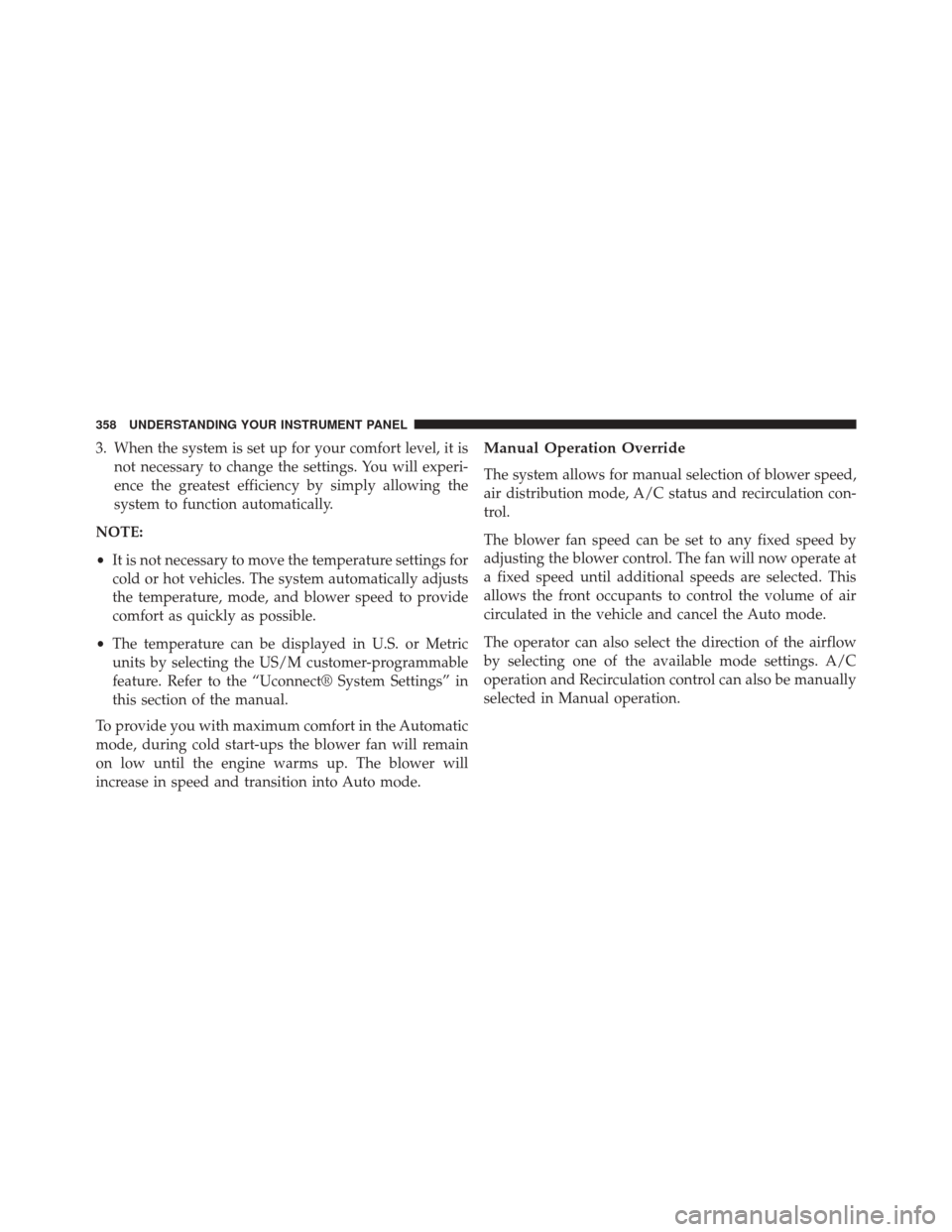
3. When the system is set up for your comfort level, it isnot necessary to change the settings. You will experi-
ence the greatest efficiency by simply allowing the
system to function automatically.
NOTE:
• It is not necessary to move the temperature settings for
cold or hot vehicles. The system automatically adjusts
the temperature, mode, and blower speed to provide
comfort as quickly as possible.
• The temperature can be displayed in U.S. or Metric
units by selecting the US/M customer-programmable
feature. Refer to the “Uconnect® System Settings” in
this section of the manual.
To provide you with maximum comfort in the Automatic
mode, during cold start-ups the blower fan will remain
on low until the engine warms up. The blower will
increase in speed and transition into Auto mode.Manual Operation Override
The system allows for manual selection of blower speed,
air distribution mode, A/C status and recirculation con-
trol.
The blower fan speed can be set to any fixed speed by
adjusting the blower control. The fan will now operate at
a fixed speed until additional speeds are selected. This
allows the front occupants to control the volume of air
circulated in the vehicle and cancel the Auto mode.
The operator can also select the direction of the airflow
by selecting one of the available mode settings. A/C
operation and Recirculation control can also be manually
selected in Manual operation.
358 UNDERSTANDING YOUR INSTRUMENT PANEL
Page 361 of 615
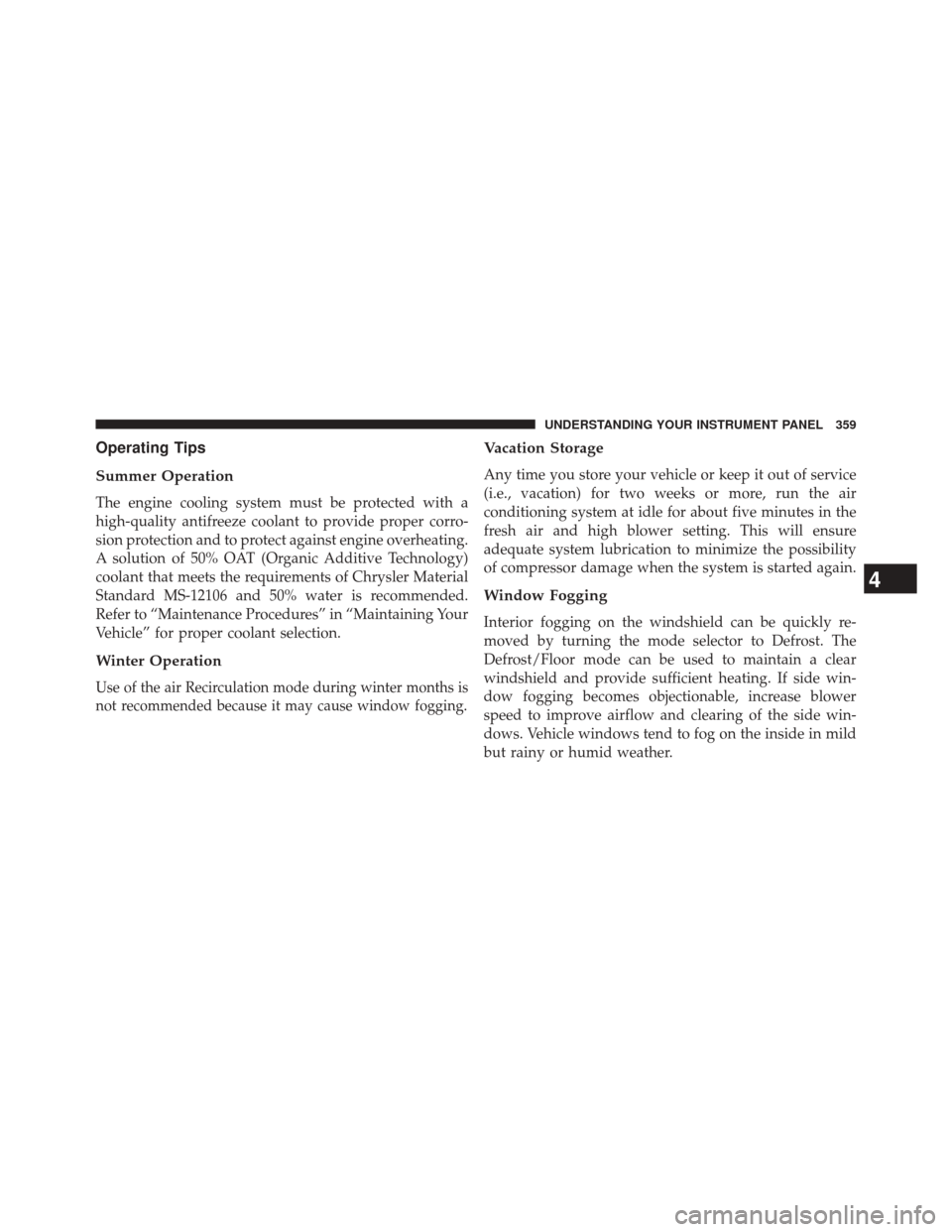
Operating Tips
Summer Operation
The engine cooling system must be protected with a
high-quality antifreeze coolant to provide proper corro-
sion protection and to protect against engine overheating.
A solution of 50% OAT (Organic Additive Technology)
coolant that meets the requirements of Chrysler Material
Standard MS-12106 and 50% water is recommended.
Refer to “Maintenance Procedures” in “Maintaining Your
Vehicle” for proper coolant selection.
Winter Operation
Use of the air Recirculation mode during winter months is
not recommended because it may cause window fogging.
Vacation Storage
Any time you store your vehicle or keep it out of service
(i.e., vacation) for two weeks or more, run the air
conditioning system at idle for about five minutes in the
fresh air and high blower setting. This will ensure
adequate system lubrication to minimize the possibility
of compressor damage when the system is started again.
Window Fogging
Interior fogging on the windshield can be quickly re-
moved by turning the mode selector to Defrost. The
Defrost/Floor mode can be used to maintain a clear
windshield and provide sufficient heating. If side win-
dow fogging becomes objectionable, increase blower
speed to improve airflow and clearing of the side win-
dows. Vehicle windows tend to fog on the inside in mild
but rainy or humid weather.
4
UNDERSTANDING YOUR INSTRUMENT PANEL 359
Page 363 of 615
STARTING AND OPERATING
CONTENTS
�STARTING PROCEDURES ................366
▫ Automatic Transmission ................366
▫ Keyless Enter-N-Go™ ..................367
▫ Normal Starting ...................... .367
▫ Extreme Cold Weather (Below –20°F Or
�29°C) ............................ .369
▫ If Engine Fails To Start .................369
▫ After Starting ....................... .371
� ENGINE BLOCK HEATER — IF EQUIPPED . . .371
� AUTOMATIC TRANSMISSION ............372▫
Key Ignition Park Interlock ...............373
▫ Brake/Transmission Shift Interlock System . . .374
▫ Eight-Speed Automatic Transmission — If
Equipped .......................... .374
▫ Five-Speed Automatic Transmission — If
Equipped .......................... .384
� AUTOSTICK® — IF EQUIPPED ............391
▫ Operation Eight-Speed Transmission — If
Equipped .......................... .391
▫ Operation Five-Speed Transmission — If
Equipped .......................... .393
5
Page 364 of 615
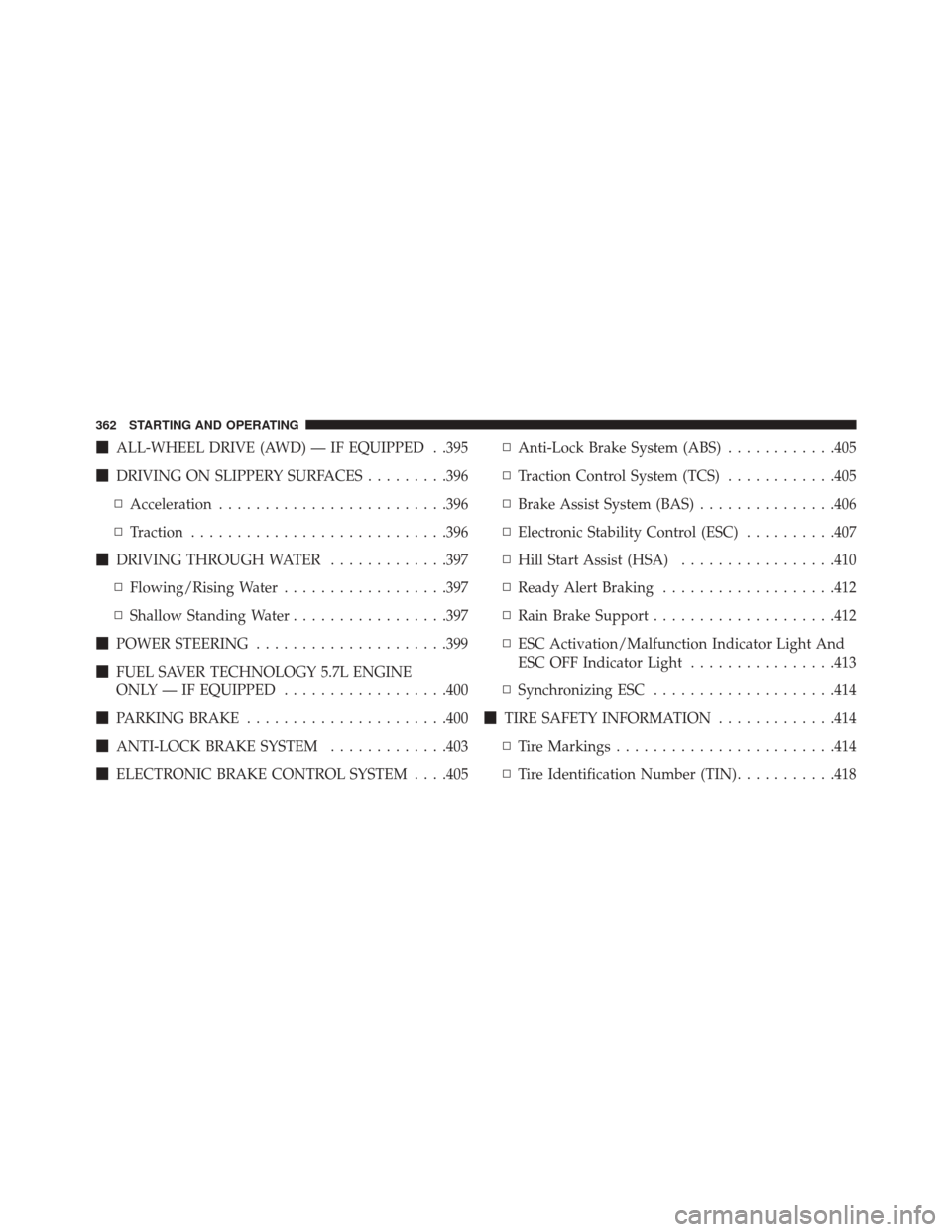
�ALL-WHEEL DRIVE (AWD) — IF EQUIPPED . .395
� DRIVING ON SLIPPERY SURFACES .........396
▫ Acceleration ........................ .396
▫ Traction ........................... .396
� DRIVING THROUGH WATER .............397
▫ Flowing/Rising Water ..................397
▫ Shallow Standing Water .................397
� POWER STEERING .....................399
� FUEL SAVER TECHNOLOGY 5.7L ENGINE
ONLY — IF EQUIPPED ..................400
� PARKING BRAKE ..................... .400
� ANTI-LOCK BRAKE SYSTEM .............403
� ELECTRONIC BRAKE CONTROL SYSTEM . . . .405 ▫
Anti-Lock Brake System (ABS) ............405
▫ Traction Control System (TCS) ............405
▫ Brake Assist System (BAS) ...............406
▫ Electronic Stability Control (ESC) ..........407
▫ Hill Start Assist (HSA) .................410
▫ Ready Alert Braking ...................412
▫ Rain Brake Support ....................412
▫ ESC Activation/Malfunction Indicator Light And
ESC OFF Indicator Light ................413
▫ Synchronizing ESC ....................414
� TIRE SAFETY INFORMATION .............414
▫ Tire Markings ....................... .414
▫ Tire Identification Number (TIN) ...........418
362 STARTING AND OPERATING
Page 365 of 615
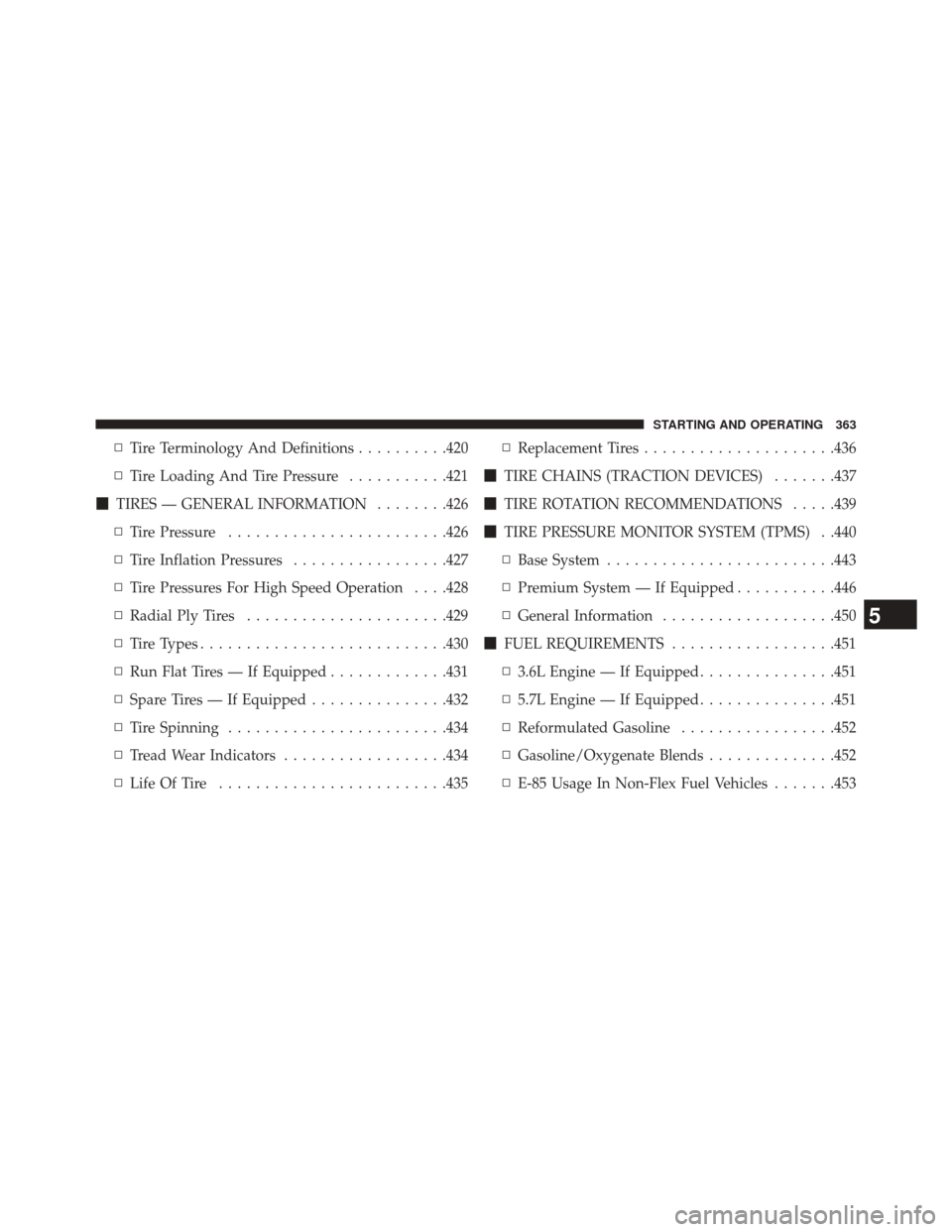
▫Tire Terminology And Definitions ..........420
▫ Tire Loading And Tire Pressure ...........421
� TIRES — GENERAL INFORMATION ........426
▫ Tire Pressure ....................... .426
▫ Tire Inflation Pressures .................427
▫ Tire Pressures For High Speed Operation . . . .428
▫ Radial Ply Tires ..................... .429
▫ Tire Types .......................... .430
▫ Run Flat Tires — If Equipped .............431
▫ Spare Tires — If Equipped ...............432
▫ Tire Spinning ....................... .434
▫ Tread Wear Indicators ..................434
▫ Life Of Tire ........................ .435▫
Replacement Tires .....................436
� TIRE CHAINS (TRACTION DEVICES) .......437
� TIRE ROTATION RECOMMENDATIONS .....439
� TIRE PRESSURE MONITOR SYSTEM (TPMS) . .440
▫ Base System ........................ .443
▫ Premium System — If Equipped ...........446
▫ General Information ...................450
� FUEL REQUIREMENTS ..................451
▫ 3.6L Engine — If Equipped ...............451
▫ 5.7L Engine — If Equipped ...............451
▫ Reformulated Gasoline .................452
▫ Gasoline/Oxygenate Blends ..............452
▫ E-85 Usage In Non-Flex Fuel Vehicles .......453
5
STARTING AND OPERATING 363
Page 366 of 615
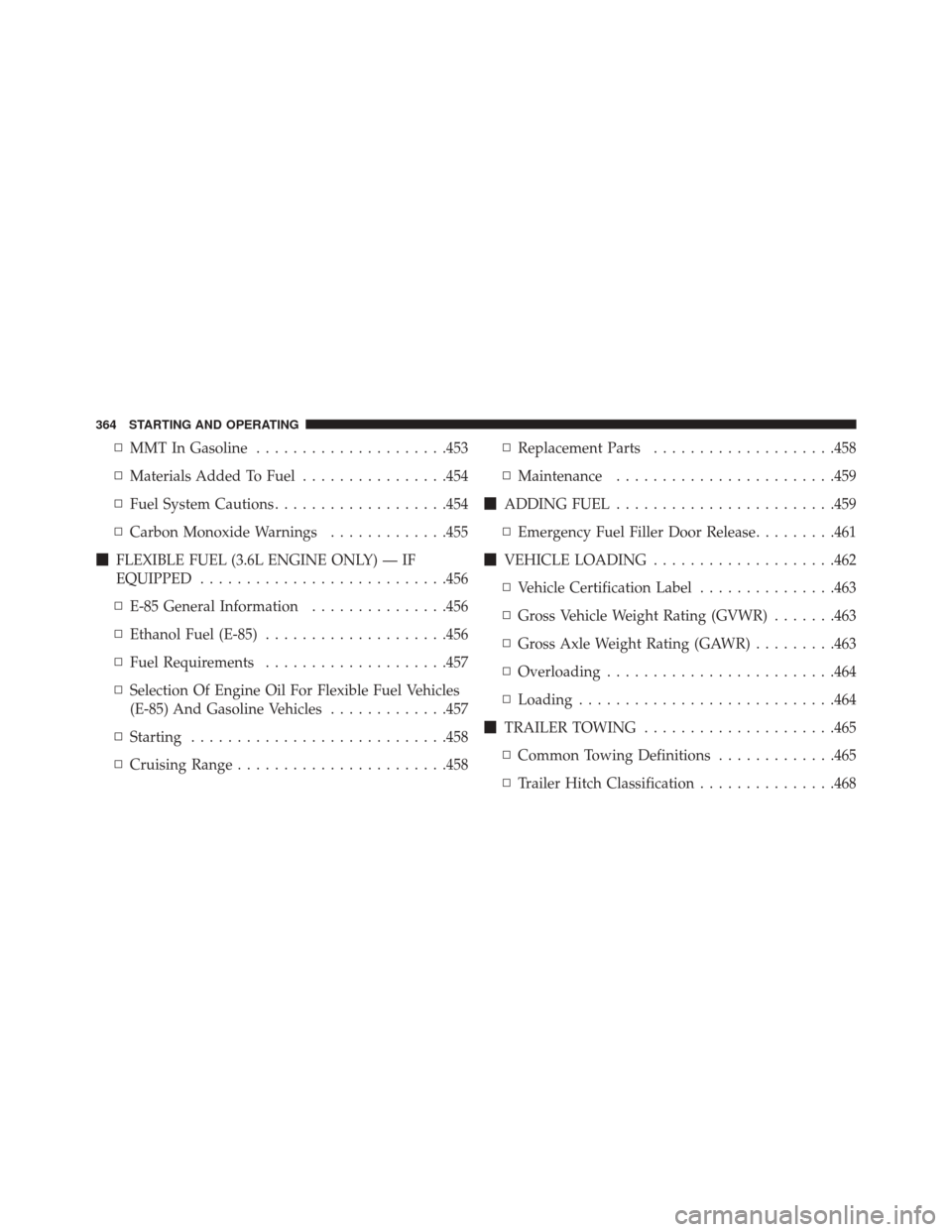
▫MMT In Gasoline .....................453
▫ Materials Added To Fuel ................454
▫ Fuel System Cautions ...................454
▫ Carbon Monoxide Warnings .............455
� FLEXIBLE FUEL (3.6L ENGINE ONLY) — IF
EQUIPPED .......................... .456
▫ E-85 General Information ...............456
▫ Ethanol Fuel (E-85) ....................456
▫ Fuel Requirements ....................457
▫ Selection Of Engine Oil For Flexible Fuel Vehicles
(E-85) And Gasoline Vehicles .............457
▫ Starting ........................... .458
▫ Cruising Range ...................... .458▫
Replacement Parts ....................458
▫ Maintenance ....................... .459
� ADDING FUEL ....................... .459
▫ Emergency Fuel Filler Door Release .........461
� VEHICLE LOADING ....................462
▫ Vehicle Certification Label ...............463
▫ Gross Vehicle Weight Rating (GVWR) .......463
▫ Gross Axle Weight Rating (GAWR) .........463
▫ Overloading ........................ .464
▫ Loading ........................... .464
� TRAILER TOWING .....................465
▫ Common Towing Definitions .............465
▫ Trailer Hitch Classification ...............468
364 STARTING AND OPERATING